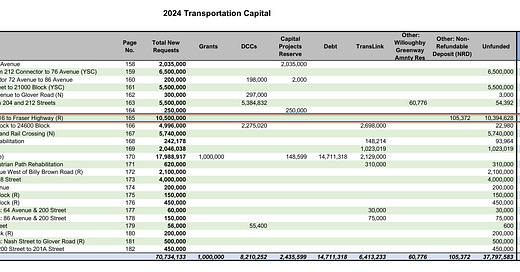Improving Township of Langley Capital Asset Budgeting
How a $1.15M digital screen might actually cost $3.7M, and other hidden infrastructure costs we're not talking about.
At the January 27th Township of Langley Council meeting, staff presented the 2025 budget to council and the public. Municipal budgeting is divided into two distinct categories: the operating budget, which covers day-to-day expenses like salaries and utilities, and the capital budget, which outlines the township's financial plan to build, repair, and replace capital assets. Examples of capital expenditures include vehicle replacements and new infrastructure like the proposed scoreboard for the Langley Event Centre.
Budget fulfilled throughout the Year
The capital budget outlines the estimated expected costs throughout the year. During budget preparation, staff includes items they anticipate will be needed or align with council priorities for the upcoming year. This draft budget is then opened to public comment. Council then evaluates Capital Requests from staff that line up with the approved budget.
An example of this is in the 2024 Budget there was a line item for restoring Old Yale Road, estimated at $10.5 million.
This was then fulfilled at the November 18th 2024 council meeting, with $9.99 million of funding to reconstruct Old Yale Road authorized via capital request.
Today's Capital Budget Structure
The current capital budget organizes items by service categories such as transportation, recreation, or solid waste and ranks them by order of importance in each service category.
Township staff consider multiple factors in their assessment:
Available grant funding opportunities
Financial stewardship principles
Council-approved bylaws and policies
Health and safety considerations
Each project receives individual attention, with detailed presentations including estimated costs, project descriptions, and justifications. Funding sources are clearly identified, whether they're coming from reserves, developer fees, grants, or debt. For multi-year projects, the budget breaks down funding sources by year.
The Missing Pieces in Our Capital Budgeting
A critical oversight in TOL's capital budgeting process is the absence of future expenditure projections (or potential savings/revenue) resulting from capital assets. Consider the 2025 Capital Budget's inclusion of two pickup trucks for bylaw enforcement, budgeted at $120,000. While the initial purchase price is clear, the ongoing costs of insurance, fuel, and maintenance aren't reflected in the capital budget, despite their significant impact on long-term township finances.
Vehicle purchases are relatively straightforward to understand since they're part of our daily experience. However, more complex items present greater challenges. Take the proposed Willoughby Park washroom facility.
While the justification cites the elimination of portable toilet rentals, the budget lacks critical information: What are the current rental costs? What will be the ongoing maintenance expenses? What about utility costs? Council is essentially making decisions without a complete picture of the long-term financial implications.
This blind spot was particularly evident in a recent council discussion about roof replacement at a recreation centre. While one councilor suggested delaying the project would increase costs by 10-15 percent the following year, no firm numbers were presented comparing immediate replacement costs (including borrowing expenses) versus delayed implementation. These decisions become based on intuition rather than comprehensive financial analysis.
A Better Approach to Capital Budgeting
Many cities have adopted more sophisticated approaches, including an "operating impact of capital" section in their budgets. This addition examines how capital investments will affect future operating budgets, estimating maintenance, utility, and staffing costs associated with new assets. For example, Edmonton's city council receives detailed reports showing projected revenues, expenses, and staffing requirements for new facilities like parks.
While many of the Township of Langley budget forms do include a similar “Estimated Annual Operating impact” section, they are rarely completed and usually left blank.
The City of Calgary periodically releases an Infrastructure Status Report which includes the value and remaining life for each asset type. In a Strong Towns article titled How to #DoTheMath for Non-Math Majors, the author uses this report to accurately estimate both the annual cost of maintaining Calgary's infrastructure and the ratio between private and public investment. This type of analysis, which combines infrastructure replacement values, asset lifespans, and property assessment data, provides a clear picture of whether a city is financially sustainable in the long term.
This shows how the Township of Langley could be creating and using similar infrastructure reports to better understand the true financial position.
The True Cost of Capital Assets
Let's examine the proposed $1.15M outdoor video display for Willoughby Stadium. The current budget presentation focuses solely on the initial investment, overlooking routine maintenance, operating costs, and eventual replacement needs. A more comprehensive analysis, assuming a 10-year lifespan and annual maintenance costs of roughly 5% of the capital cost, reveals that maintaining this screen until 2049 would cost the Township approximately $3.7M.
While a 25-year projection for a digital screen might seem excessive, this example highlights a crucial point: what about infrastructure that can't simply be abandoned? Road expansions and sewer lines create long-term commitments that the township must maintain and eventually replace.
Looking Forward
TOL’s capital budgeting process needs enhancement. Council requires better information about long-term cash flows to make informed decisions about acquiring, delaying, or canceling capital assets. By incorporating lifecycle costing and operational impact analyses, it is possible to build a more sustainable approach to infrastructure investment and maintenance.
The future of the Township of Langley depends on making well-informed decisions today about the infrastructure that will serve the community for decades to come. It's time to upgrade the capital budgeting process to match the complexity and long-term nature of these investments.
A letter outlining these concerns will also be sent to the Financial Division of the Township of Langley as part of the feedback on the budget process.
Strong Towns Langley is a community group dedicated to making Langley, British Columbia a better place. We advocate for incremental development, sustainable transportation solutions, housing accessibility, public spaces, and responsible growth strategies. Our group is part of the larger Strong Towns movement, focusing on creating financially resilient and people-oriented communities.
To learn more visit https://strongtownslangley.org









